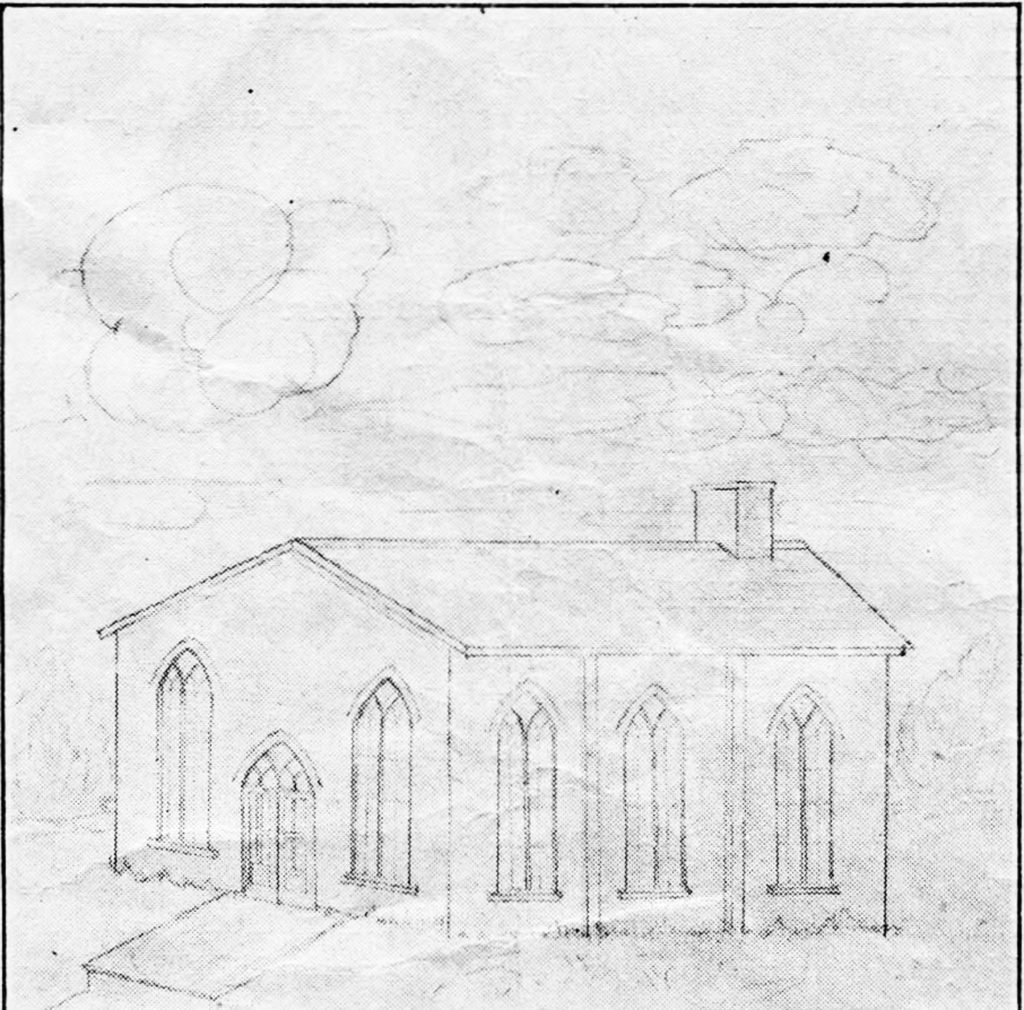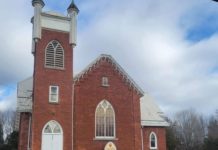The news that the United Church in Oxford Mills is set to close soon means that the three original churches in the village will now be gone. The other two, the Anglican and Presbyterian buildings, have already been changed into private residences; both maintaining the exteriors in a way that is very sensitive to their heritage character. Now it will be the turn of the United Church, though what its future will be is still uncertain.
This is, in fact, the third church on this site; the first was built as a Methodist church in 1858, and previous to that the local Methodists met from house to house, with a visiting minister coming through on his circuit of congregations stretched across Eastern Ontario. The land was bought from Rickey Waugh a couple of years after the church was built, for the princely sum of £5. The building was brick, with large windows along the sides and on each side of the front door, which actually required extra structural supports within the building, as the windows weakened the walls. It was not the last time enthusiastic builders would regret their rushed construction.
A bottle was placed in the cornerstone of the building on September 14, 1858 as a time capsule, containing “a copy of the Christian Guardian, one number of the Prescott Telegraph newspaper”, and a paper noting that the time capsule had been deposited by three Ministers, David Creighton McDowell, Joseph Kilgour, and Henry Shaler, and at the request of the Trustees of the congregation, familiar names in the community: Horace Hutchins, Reuben Clothier, Samuel Beach, John Russell and Augustus Boyd.
Oxford Mills was part of a circuit, a group of churches sharing a Minister, which included Kemptville, Heckston, and South Mountain. But the local congregation continued to grow and the old building was becoming too small to cater for the increase.
The original building served until 1881, when it was decided to erect a “more modern” church, complete with a spire and belfry. Oxford Mills Methodist Church was now at a point where it could afford its own resident minister, who lived in a rented house in the village. But the new church proved to be unsound, a second building with construction problems. In 1897, just sixteen years after it was built, part of the building collapsed and the entire structure had to be torn down. And so the present church rose up on the foundations of the old, constructed of common bond red brick with a corner bell tower topped with four turrets. The interior features an intricate pattern of tongue and groove panelling on the walls and ceiling designed and installed by Ormond Barnard, a local resident who had a long career as an inventor and builder. The two almost identical houses across the road from Oxford-on-Rideau Public School were built by Ormond, and it was in his workshop that the first Anglican services were held until that congregation built their own building.

The two congregations, Methodist and Presbyterian, joined together in 1883 to buy land south of the village for use as a burial ground. Burials in the cemetery adjacent to the Presbyterian Church were moved to this new cemetery, and the Anglicans added their own burial ground immediately adjacent to the Union Cemetery land. This cemetery continues in use, even now that the last of the churches in the village is closing.
In 1889 the congregation bought the lot south of the church. This had been the location of the first school building in Oxford Mills. When the school was moved to Maplewood in 1875, the land was sold and a house built there. This house was used as the Parsonage until it was sold in 1913 and the house was moved down the road to its current location at 22 Water Street. The congregation bought the lot to the north of the church in April, 1913 and that house became the new parsonage. It was sold only a few years ago, as the church could no longer afford a resident minister.
In 1925 the United Church was inaugurated when the Methodist Church, Canada, the Congregational Union of Canada, and 70 per cent of the Presbyterian Church of Canada entered into a union. The Methodist Church in Oxford Mills now became the United Church. So many generations have passed through the United Church in Oxford Mills since those early pioneers in 1858. For so long the three churches, and the school, were the focus of community life at a time when Oxford Mills was largely self-contained with a large and active population. The closing of the last church in the village marks the end of an era that is unlikely to be repeated.







